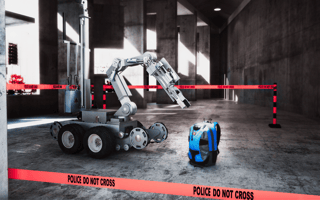Police robots are designed to make stops, arrests and other intense situations less dangerous. They assist police forces with everything from surveillance to clearing debris from accident scenes to even detonating bombs.
For instance: To safely respond to a standoff with an arsonist in 2019, police in Novato, California sent a robot — instead of a human officer — to deliver a cell phone for negotiation.
That’s just one of countless stories involving police robots, which have grown increasingly popular. From handing out speeding tickets and patrolling streets to taking down armed suspects and diffusing bombs, robots have become an effective crime-fighting tool that can save both labor and lives.
What Are Police Robots?
Police robots are not too different from other types of robots, as they all use AI, machine learning and IoT to perform their tasks. The main difference between a police robot and a service robot, for example, is the task they are programmed to carry out. Police robots used by law enforcement and government agencies are programmed to make traffic stops based on driving patterns, use facial recognition to detect criminals and even prevent fraud.
One of the first police robots was deployed in 2017 within Dubai’s police department. Dubbed “Robocop,” the robot uses IoT and AI technology to recognize human emotions, and its intention is to help the people of Dubai “in the malls or on the streets,” Brigadier-General Khalid Nasser Al Razzouqi, director-general of smart services at Dubai Police, told the Khaleej Times.
“The Robocop is the latest smart addition to the force,” he added, “and has been designed to help us fight crime, keep the city safe and improve happiness levels.”
Police robots can come in many forms. Whether it’s Robocop’s humanoid form, robot “dogs” or a less elegant traffic stop robot with a camera and screen, robots are changing the way we police our communities.
Benefits of Using Police Robots
Some say that, in addition to supplementing workforces — by taking over the inherently risky task of issuing speeding tickets and other traffic stop duties, for example — robots can keep officers safe and eliminate some bias in policing.
Increased Police Efficiency
Robots don’t have to take breaks, which allows them to be available for duty for extended periods of time. This also makes them an asset when it comes to completing repetitive tasks and assisting in surveillance, such as patrolling an area or quickly identifying potential suspects in a crowd. For example: K5, an autonomous security robot, was deployed in an October 2023 trial by the New York City Police Department (NYPD) to help surveil activity in the Times Square subway station and act as a 24/7 communication line for passersby.
Reduced Human Exposure to Danger
In 2013, a robot helped police catch the Boston Marathon bombers. A few years later, after a man murdered five police officers in Dallas, Texas, and threatened to shoot more in a parking garage standoff, police decided to avoid further casualties and send in a pound of C4 plastic explosive. Delivered by an 800-pound robot from Northrop Grumman, the material detonated and killed the suspect.
“Other options would have exposed our officers to grave danger,” Dallas police chief David Brown said during a press conference at the time.
“If an officer goes into a room and there’s an armed adversary, he has no choice except to shoot,” Sean Bielat, the former CEO of Endeavor Robotics, told Business Insider. “By adding time and space between the operator, you’ve introduced an element that can potentially reduce casualties.”
Reuben Brewer, a senior robotics researcher at SRI International, invented a robot that allows cops to make roadside stops without exiting their squad cars.
“The main advantage of a robot over a human is that physical danger no longer matters,” he told the Washington Post. “The robot is purely defensive, so it can’t hurt the motorist. If the motorist damages the robot, it’s only money to replace it.”
Brewer also noted that, “people are more dangerous when they’re scared, so the goal is to remove the possibility of being physically hurt so that they’re less scared and less dangerous.”
May Reduce Unnecessary Traffic Stops or Ticketing
Combining robotics with self-driving technology could allow for police vehicles with the ability to autonomously flag down drivers and write traffic violation tickets — all without a police officer present. Some propose that this can reduce police stops on the road that are due to filling ticket quotas, or maybe just due to human suspicion.
“You will have fewer pre-textual stops,” one police-robot supporter told the Washington Examiner. “Once expectations are adjusted, you will have fewer issues with cops pulling over a car because they don’t look like they fit [in a certain neighborhood] or tailing a car for miles waiting for them to do something nominally wrong.”
Another proponent told the publication that robotic policing could yield “potentially big benefits for equity, privacy and safety — for both police and drivers.” He continues that getting pulled over would be determined purely by data about driving behavior, rather than any preconceived bias. “It should cut down on stops where some minor, possibly imaginary infraction is used as an excuse to detain someone and poke around their car for other reasons.”
Disadvantages of Using Police Robots
Some fear that robots might do more harm than good. Even the NYPD canceled its use of Boston Dynamics’ “Digidog” in 2021, after receiving backlash from the community and public officials.
Bias and Misidentification of Suspects
While robots might not have an inherent racial bias, for instance, that doesn’t mean the underlying AI technology is perfect. In fact, as MIT Media Lab researcher Joy Buolamwini found, it’s not even adequate: People with dark skin are misidentified by facial analysis software far more often than their lighter-skinned counterparts. Some of these police robots employ that sort of technology.
“People of color are in fact the global majority,” Buolamwini told Boston Magazine. “The majority of the world, who I like to call the under-sampled majority, aren’t being represented within the training data or the benchmark data used to validate artificial intelligence systems. We’re fooling ourselves about how much progress we’ve made.”
She added that those who already are more likely to be targeted by police “are least represented [in face-recognition code],” which puts them “at higher risk of being misidentified as a criminal suspect. Because we live in a society that reflects historical biases that continue to this day, we have to confront the kind of data we’re generating, the kind of data we’re collecting, how we’re analyzing it. And we need to do it with diverse eyes in the room, diverse experiences and more gender parity.”
Using robots to deal with mentally ill suspects is a risky proposition, too, as evidenced by Maine police blowing up a civilian’s house in 2018.
May Be More Forceful Than Human Police
Then there’s the possibility of excessive violence.
Speaking with Politico Magazine in 2016, Jay Stanley, a policy analyst at the American Civil Liberties Union, wondered if robots should be used by police only in “extraordinary circumstances” or if they should “start clamoring for robots specifically designed to use force.”
Absent the judgment of human police officers, Stanley went on, robots might act too forcefully in situations that call for nuance and restraint.
“Let’s say there’s a protest, and there aren’t any police on the scene,” he said. Police robots could potentially unload “pepper spray, or tear gas, or rubber bullets, on the crowd … and they hit people who are not involved, or they do it when it’s not necessary.” It’s a bleak picture.
A story by Kate Knibbs from The Ringer echoed similar concerns: “As law enforcement continues to stockpile and grow stashes of military-grade robots and weaponized drones,” Knibbs wrote, “the opportunities to use these tools are bound to increase.”
Would Require Legal and Societal Adjustments
In a 2016 PBS Newshour interview following the robotic disarming of bombs in New York and New Jersey, author and New America senior strategist Peter W. Singer said the issue of robots in law enforcement “has to involve not just the police, but also the populace, the people that are to be protected and served by the police and the tools, including the robotic ones, that they use.”
And in a lengthy analysis of police and military robots for the UCLA Law Review, U.C. Davis law professor Elizabeth E. Joh posed a variety of cautionary questions.
“Even if this use of robots is still just a concept, we can anticipate the kinds of legal and policy challenges that might arise,” she wrote. “First, how much should humans remain ‘in the loop’—maintain some degree of involvement, in other words—in the use of robot police? Second, how much coercive force should we permit police robots to exercise? Third, how might the use of police robots affect legal determinations like reasonable force? Fourth, will the use of police robots further reinforce the social inequities in policing? Finally, how can we develop a uniform approach to policing police robots?”
Not long after the casualties of police in Dallas, Texas, Singer and his colleague Emefa Addo Agawu argued that it’s less a question of “whether we want robotics involved across various areas of life” and more one of how.
“And where police and robots are concerned,” they added, “the debate cannot be separated from the heated discussions about what role we want police to play in society.”
Companies Building Police Robots
Check out some companies that make a variety of robots for police and other law enforcement personnel.
Location: San Mateo, California
Cobalt’s robots are autonomous patrol vehicles that can detect possible risks (human or otherwise), clear false alarms and alert response specialists to potential dangers. They even transmit data-rich status and incident reports on a regular basis.
Location: Mountain View, California
Knightscope’s series of stationary and roving sentinel robots monitor entrances and exits of buildings and venues. They can understand human language in a variety of environments, self-charge, run around the clock and work in large areas that include corporate campuses and hospitals. Knightscope is also behind the K5 robot used by the New York City Police Department in 2023, which helps with patrolling efforts in the city’s subway system.
Location: Herndon, Virgina
Peraton Remotec’s Andros series of camera-equipped robots are designed for an array of public safety purposes. The various models can maneuver in tight spaces, climb stairs, lift objects, speed across rough terrain and even use weapons.
Location: Edina, Minnesota
ReconRobotics’ ThrowBot 2 Robot is designed to do just what its name suggests: be thrown. Not only that, it’s supposedly capable of being dropped repeatedly onto concrete from up to 30 feet, can capture and transmit audio and video in real time, crawl over different types of terrain, clear obstacles and lug payloads of up to four pounds.
Location: Sausalito, California
SMP Robotics makes a variety of security robots that are equipped with high-definition cameras, long-range loudspeakers, autonomous vehicle control systems and AI-powered thermal and panoramic surveillance capabilities. These robots are built to patrol outdoor areas in various conditions and counteract intrusion for medical centers, power plants or other large facilities.
Location: Fuquay-Varina, North Carolina
SuperDroid’s products include robots for tactical and surveillance applications. Law enforcement-friendly functions include remote surveillance, stair climbing capabilities, night vision, underwater maneuvering, security and patrolling, bomb detection and more.
Location: Wilsonville, Oregon
In 2019, Teledyne FLIR acquired Endeavor Robotics, the merger allowed Teledyne FLIR to expand its combat and public safety sectors. Some of the company’s public safety robots include Firstlook, Packbot and SUGV. These robots assist SWAT teams with hostage situations, diffuse explosives and serve high-risk warrants.
Frequently Asked Questions
How are robots used in police?
Police robots are used to supplement the police workforce and assist in completing repetitive or dangerous tasks, such as surveillance and patrolling, conducting traffic stops or diffusing weapons and suspect standoffs.
What does the NYPD K5 robot do?
The K5 robot deployed by the New York City Police Department (NYPD) aims to patrol and record criminal activity in the Time Square subway station during overnight hours. It is also equipped with a 24/7 live button passersby can press to alert police officers of an incident.









